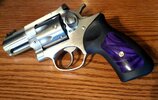I will admit that Quickload is not perfect. However, as previously noted AA9 published load data is "all over the map" (i.e. not perfect either).
And as far as using data with pressure in cup, that is my last resort. Hercules powder data allowed much higher charges based on the old cup style testing, and then found they need to back down when they went to the more accurate psi method. This was back in the early 1990s as I recall.
Again if there was real test data with a Zero 158 JHP bullet and the powders listed in the OP, recommendations would be easier. As it is, having the Quickload runs is going to provide about as good a comparison as you are going to get for this bullet loaded to this COAL with these specific powders.
As best I can tell, when Quickload is more than a tad bit different than published load data for magnum pistols, it tends to be on the conservative side most of the time (i.e. give results that indicate a lower max charge). However, I have seen some examples where using Quickload would allow higher charges than actual test data.
As far as pushing 357 mag to max pressure, I have to ask why. When you have actual test data for the specific bullet in question, the risk is low. When you are using test data from one bullet to estimate performance for a different bullet are you really confident that your bullet will not increase pressure. Again look at published data for the 357 mag and you can find all kinds of unexpected variations for what look to be very similar loads.
And stopping short of recommending absolute max is something of a "standard practice" for me for this type of application. If there was a stated need to push for absolute max performance, using a "generic" bullet is probably a poor choice. I would recommend finding a specific bullet that is an exact match to data with results in psi from a couple of sources and duplicating one of the published loads as close as possible.
In truth, the OP stated the intention to fire these loads in a GP-100. For that specific gun, there is probably less need for my caution. However, anything I recommend can be used by anybody reading this thread and they may have a much less heavy duty gun. Remember what we are doing here guys. For probably better than 95% of the time, reloads are used to support shooting as a hobby. If I want a more powerful round than a 30,000 psi 357 magnum, my first choice is simply to use more gun. Pushing loads out to where you increase the risk of gun damage (or worse) just does not make sense to me when we are talking about the normal use of reloads.


